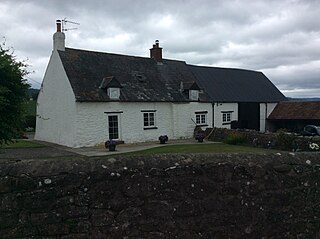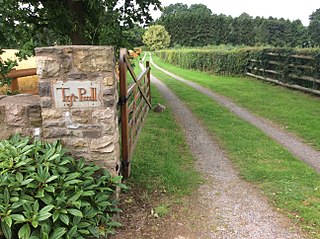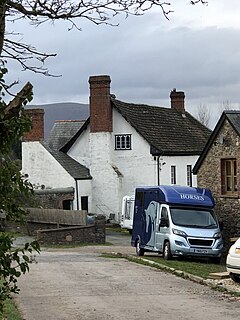
Clytha Park, Clytha, Monmouthshire, is a 19th-century Neoclassical country house, "the finest early nineteenth century Greek Revival house in the county." The wider estate encompasses Monmouthshire's "two outstanding examples of late eighteenth century Gothic", the gates to the park and Clytha Castle. The owners were the Jones family, later Herbert, of Treowen and Llanarth Court. It is a Grade I listed building.

Monmouthshire is a county and principal area of Wales. It borders Torfaen and Newport to the west; Herefordshire and Gloucestershire to the east; and Powys to the north. The largest town is Abergavenny, with the other major towns being Chepstow, Monmouth, and Usk. The county is 850 km2 in extent, with a population of 93,600 as of 2019. The present county was formed under the Local Government (Wales) Act 1994, and comprises some sixty percent of the historic county. Between 1974 and 1996, the county was known by the ancient title of Gwent, recalling the medieval Welsh kingdom. In his essay on local government in the fifth and final volume of the Gwent County History, Robert McCloy suggests that the governance of "no county in the United Kingdom in the twentieth century was so transformed as that of Monmouthshire".

Allt-y-Bela in Llangwm, Monmouthshire, Wales, is a house of late medieval origin with additions from the sixteenth to the twenty-first centuries. During the early seventeenth century, it was owned by Roger Edwards, a wealthy Midlands merchant and the founder of Usk Grammar School. Edwards made significant alterations in the Renaissance style to the medieval cruck house. By the twentieth century, the house was in ruins until restored by the Spitalfields Historic Buildings Trust in the early twenty-first century. Now owned by the garden designer Arne Maynard, the house is a Grade II* listed building recognising its significance as an "exceptionally important sub-medieval house with ambitious early renaissance additions".

Llwyn-celyn Farmhouse, Llanvihangel Crucorney, Monmouthshire is a farmhouse of late medieval origins. It is a Grade I listed building.

Church Farmhouse, Kemeys Commander, Monmouthshire is a former parsonage dating from the mid-16th century. The farmhouse and the attached barn are Grade II* listed buildings.

The Barn at Lower Tresenny, Grosmont, Monmouthshire is an "extremely rare" example of a cruck-framed barn. It dates from the mid 16th century. The barn is a Grade II* listed building.

Pwll, Tregare, Monmouthshire is a medieval cruck-house dating from the late 14th century, with additions in the 17th century. An "extremely rare survival", the house was derelict by the mid-20th century, and was reconstructed in the mid-1990s. It is a Grade II* listed building.

Ton Farmhouse, Llangybi, Monmouthshire is a farmhouse dating from the early 17th century. John Newman, in his Monmouthshire Pevsner, describes it as a "perfect Monmouthshire farmhouse". Ton is a Grade II* listed building, its listing noting that it is a "remarkably good survival" of a prosperous 17th century Welsh farmhouse.

Great House, Llanarth, Monmouthshire is a farmhouse dating from the late-16th century. Extended in the mid-17th century and little altered thereafter, it is a Grade II* listed building. The detached barn range has its own Grade II listing.

The barn, stable and granary at Cwrt y Brychan , Llansoy, Monmouthshire are a range of farm buildings constructed in the 16th century. The origins are the site are ancient and the court is historically connected with the kingdom of Brycheiniog. The complex has a Grade II* listing, with the court having a separate Grade II listing.

The Barn at Croft Farm, Llantilio Crossenny, Monmouthshire is a remarkably rare example of a 16th-century barn. Originally built as part of the Great Tre-Rhew Estate, it is a Grade II* listing building.

Wern-ddu farmhouse, Llantilio Pertholey, Monmouthshire is a farmhouse of 17th century origins. It has been significantly altered in the 18th, 19th and 20th centuries and the Monmouthshire antiquarian, Sir Joseph Bradney recorded that it had "suffered so much by continual alterations that it shows but little of its antiquity". It is a Grade II* listed building.

Great Killough, Llantilio Crossenny, Monmouthshire is a substantial manor house of late medieval origins. The majority of the current structures date from three building periods from 1600 to 1670. It is a Grade II* listed building.

Blaengavenny Farmhouse, Llanvihangel Crucorney, Monmouthshire is a farmhouse of late medieval origins. It is a Grade II listed building. Its adjacent barn and granary have separate Grade II listings.

Chapel Farmhouse and its attached outbuilding, Llanarth, Monmouthshire is a house dating from the 16th century. Greatly enlarged in the 17th century, it remains a private house. It is a Grade II* listed building.

Upper Tal-y-fan, Dingestow, Monmouthshire is a farmhouse dating from the late-Medieval period. Subsequently enlarged, it remains a private house and is a Grade II* listed building.

Upper Green, Llantilio Crossenny, Monmouthshire is a farmhouse dating from the Medieval period. The original hall house was enlarged in the 17th century. In the 18th century, a substantial new farmhouse was built which incorporated the hall house as a service wing. Upper Green remains a private house and is a Grade II* listed building.

Berllan-deg, Llanhennock, Monmouthshire is a country house dating from the mid-17th century. A rare survival of a remarkably unaltered hall house, Berllan-deg is a Grade II* listed building.

Persondy , Mamhilad, Monmouthshire is a former parsonage dating from the late 16th century. It is a Grade II* listed building. The adjacent barn, now a separate residence called Ysguborwen, has its own Grade II listing.

Lower Celliau,, Llangattock Lingoed, Monmouthshire is a farmhouse dating from the 16th century. It is a Grade II* listed building. The adjacent barn and shelter, and cowhouse and stable have their own Grade II listings.





















